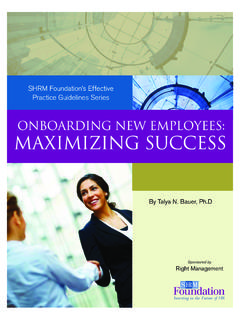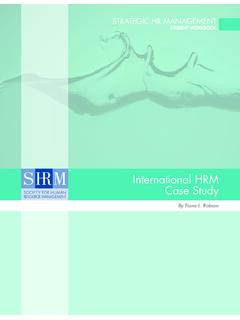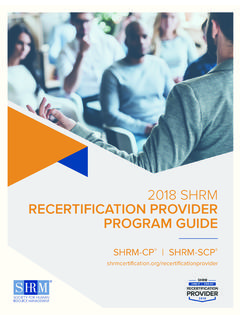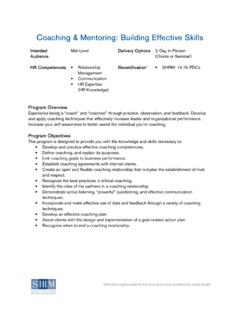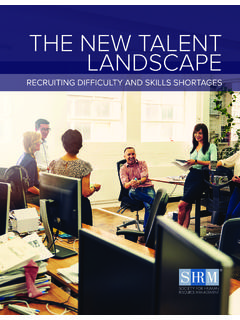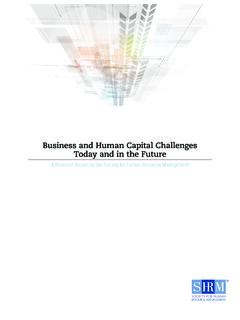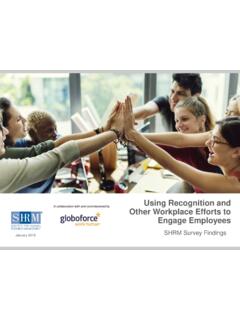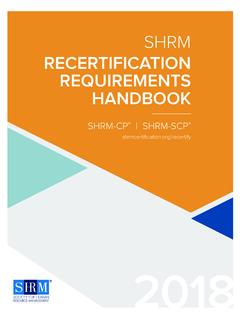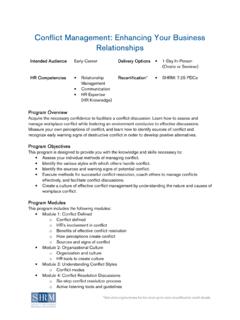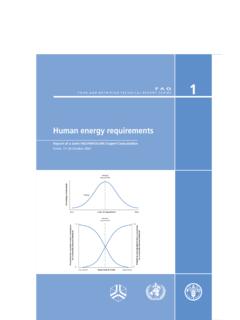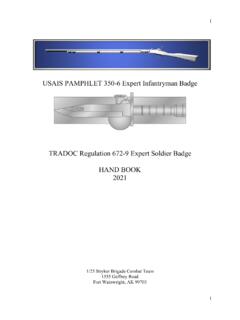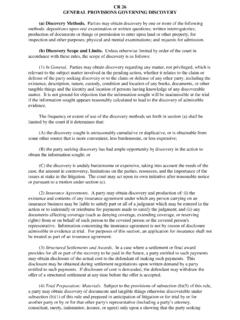Transcription of Research Employee Engagement - SHRM
1 SHRM Research Overview: Employee EngagementSHRM Research Overview: Employee EngagementSHRM Research Overview: Employee EngagementEmployee Engagement has long been an important topic for organizations. Over the past decade, HR professionals, con-sultants and researchers have linked Employee Engagement to a number of critical human capital and business outcomes within organizations, including stronger intentions to leave, increased staff turnover, and low Employee morale and over-all satisfaction at work. Organizations today invest a considerable amount of finan-cial and staff resources to actively measure, track and man-age levels of Engagement among their employees. Dedicated teams of HR professionals are assembled to accomplish these activities through targeted pulse and annual surveys, action planning activities, and leadership and managerial interventions and strategies.
2 As a result, it is critical that HR professionals understand how Employee Engagement is defined within organizations, the role it plays in driving staff morale and productivity, and the implications levels of Engagement have on human capital management and overall business SHRM Research has found that HR professionals, executives and other business leaders frequently cite human capital management as a top priority for achieving economic success, and any related discussion must include Employee Engagement . Levels of Employee Engagement are typically defined by the actual conditions in the workplace and work-ers opinions and behaviors as they relate to their jobs. SHRM Research has shown that employees Engagement levels are often determined by the strength of their relation-ships with supervisors and co-workers, as well as their belief in their own ability to perform their jobs effectively and contribute to their organization.
3 Other findings show that maintaining high levels of Employee Engagement is viewed as a significant challenge among HR professionals and Want to Feel Valued and IncludedAlthough there are some financial factors that determine employees levels of Engagement with their jobs, many workers place more weight on relationships and the work itself. Engagement levels can also vary among job catego-ries, and those in supervisory and executive positions are frequently more engaged with their work than are hourly employees and individual On a scale of 1 to 5, with 1 being the least engaged and 5 being the most engaged, employees were moderately engaged in 2015, with an overall index of , similar to prior years ( in 2014 and in 2013), according to SHRM s Employee Job Satisfaction and Engagement In 2015, two elements tied as the Engagement condi-tion with which most employees reported being satisfied (77%): relationship with co-workers, and opportunities to use their skills/abilities in their work (see Figure 1).
4 Career advancement opportunities within the organiza-tion were the Engagement condition that was cited by the fewest employees as being satisfactory (57%). Several Engagement conditions varied depending on job level. Middle-management employees were more likely than nonexempt (hourly) employees to be satisfied with cer-tain Engagement conditions, as shown in Figure 2. Nearly nine out of 10 employees either said they were confident they could meet their work goals (89%) or were determined to accomplish their work goals (86%), as illustrated in Figure 3. Similar to conditions for Engagement , results for Engagement opinions varied according to job level (see Figure 4). For example, more middle-management employees (72%) than nonexempt (hourly) employees (55%) said they had passion and excitement about their work. SHRM Research Overview: Employee EngagementSHRM Research Overview: Employee EngagementSHRM Research Overview: Employee EngagementSHRM Research Overview: Employee EngagementFigure 2: Differences in Engagement Conditions Based on Job Level77%82%69%Opportunities to use skills/abilities76%81%66%Meaningfulness of the job69%77%58%Variety of work Overall Middle management Nonexempt (hourly employees)Note: Figure represents the percentage of responding employees who indicated being somewhat satisfied or very satisfied with each job satisfaction aspect.
5 Percentages are based on a scale where 1 = very dissatisfied and 5 = very satisfied. Respondents who indicated not applicable were excluded from this : Employee Job Satisfaction and Engagement (SHRM, 2016)Figure 1: Conditions for EngagementVery DissatisfiedSomewhat DissatisfiedNeutralSomewhat SatisfiedVery SatisfiedOverall SatisfactionRelationship with co-workers2%3%17%41%36%77%Opportunities to use skills/abilities2%5%16%40%37%77%Meaningf ulness of the job2%5%17%42%34%76%The work itself2%6%17%40%34%74%Relationship with immediate supervisor3%7%16%34%40%74%Organization s financial stability2%7%19%40%33%72%Contribution of work to organization s business goals2%3%22%42%30%72%Autonomy and independence2%9%18%39%32%71%Variety of work3%8%20%39%30%69%Overall corporate culture3%10%19%41%28%69%Communication between employees and senior management6%14%16%39%25%64%Organization s commitment to corporate social responsibility4%7%27%39%24%63%Management s recognition of Employee job performance6%12%18%37%26%63%Job-specific
6 Training3%12%25%37%25%61%Organization s commitment to professional development4%11%25%34%25%59%Networking opportunities4%10%28%36%23%58%Career development opportunities4%13%25%37%21%58%Career advancement opportunities within the organization5%15%23%33%24%57%Note: Percentages are based on a scale where 1 = very dissatisfied and 5 = very satisfied. Not applicable responses were excluded from this analysis. Data are sorted in descending order by the overall satisfaction : Employee Job Satisfaction and Engagement (SHRM, 2016) WHAT THE EXPERTS ARE SAYINGK aren Paul, Leader of the Global Measurement Center of Expertise, 3MA number of interesting reports are emerging that indicate business leaders are feeling they are not realizing the benefits of Employee Engagement initiatives. One interpretation could be that Employee Engagement initiatives don t work.
7 Yet, CEOs are citing Employee Engagement as one of their top five global business strategies for their organizations, and the topic is clearly rising in the minds of business leaders. There is also a soon-to-be-billion-dollar industry that has arisen to support and advise around these initiatives. Perhaps another interpretation could be that the sentiment is more a reflection of the enormous and ever-increasing challenges due to the fast-moving business landscape than any actual disconnection of organizational outcomes derived from positive work attitudes. To read the full Perspectives article from which this excerpt is taken, visit SHRM Research Overview: Employee EngagementSHRM Research Overview: Employee EngagementFigure 3: Engagement Opinions Strongly DisagreeDisagreeNeutralAgreeStrongly AgreeOverall AgreementI am confident I can meet my work goals1%2%8%40%49%89%I am determined to accomplish my work goals1%2%11%43%43%86%I have a clear understanding of my organization s vision/mission2%4%17%46%31%77%I am highly motivated by my work goals2%5%17%40%37%76%While at work, I m almost always completely focused on my work projects1%8%20%44%27%71%I am provided with the resources to do my job well2%11%19%44%24%68%I frequently feel that I m putting all my effort into my work2%6%24%39%29%68%I have passion and excitement about my work2%8%24%39%26%66%I am often so wrapped up in my work that hours go by like minutes3%10%24%33%31%64%I enjoy volunteering for activities beyond my job requirements3%13%27%35%22%57%I feel completely plugged in at work.
8 Like I m always on full power2%12%31%35%20%55%Note: Percentages are based on a scale where 1 = strongly disagree and 5 = strongly agree. Data are sorted in descending order by overall agreement : Employee Job Satisfaction and Engagement (SHRM, 2016)Figure 4: Differences in Engagement Opinions Based on Job Level86%90%78%I am determined to accomplish my work goals66%72%55%I have passion and excitement about my work64%71%56%I am often so wrapped up in my work that hours go by like minutes Overall Middle management Nonexempt (hourly employees)Note: Figure represents the percentage of respondents who agreed or strongly agreed with statements on Engagement opinions and behaviors. Percentages are based on a scale where 1 = strongly disagree and 5 = strongly agree. Respondents who indicated not applicable were excluded from this : Employee Job Satisfaction and Engagement (SHRM, 2016)Employees Perceptions of Colleagues Also Contribute to EngagementEngagement behaviors, or the look of Employee engage-ment, can be described as actions that positively contrib-ute to the welfare of the organization.
9 These behaviors encompass Employee groups rather than the Engagement of individual employees. Employers should consider these when developing strategies for Employee Engagement , as workers perceptions of their colleagues actions can also affect their levels of Engagement . A sizable majority of employees (70%) said that in their organizations employees are encouraged to take action when they see a problem or opportunity, according to the 2015 Employee Job Satisfaction and Engagement report (see Figure 5). Nearly two-thirds (65%) said their col-leagues quickly adapt to challenging or crisis Research Overview: Employee Engagement There were few differences in Engagement behaviors among demographic groups, according to the same report. Middle-management employees were more likely than nonexempt (hourly) workers to agree that other people in their organizations often volunteered for new Employers are using a number of tactics to improve Employee Engagement , according to other recent Research by SHR M.
10 More than four out of five (83%) HR profes-sionals said Employee recognition programs had a posi-tive impact on Employee Engagement , as shown in Figure 6, and more than half (53%) said service anniversary programs were either an excellent or a good method to increase Employee Engagement (see Figure 7).4 Figure 5: Engagement Behaviors Strongly DisagreeDisagreeNeutralAgreeStrongly AgreeOverall AgreementIn my organization, employees are encouraged to take action when they see a problem or opportunity2%9%20%46%24%70%My colleagues quickly adapt to challenging or crisis situations1%11%24%43%22%65%My work group never gives up despite difficulties1%9%26%43%21%64%Employees in my organization deal very well with unpredictable or changing work situations3%10%26%41%21%61%In my work group, we are constantly looking out to see what challenge is coming next2%12%30%38%19%57%The people in my work group are always flexible in expanding the scope of their work3%12%31%38%17%55%Others in my organization view unexpected responsibilities as an opportunity to succeed at something new4%14%30%37%16%53%Other people in my organization often volunteer for new projects4%18%31%32%16%48%Note: Percentages are based on a scale where 1 = strongly disagree and 5 = strongly agree.
